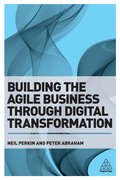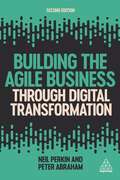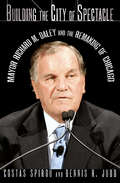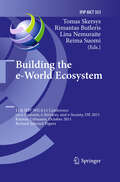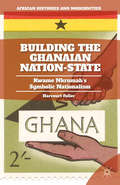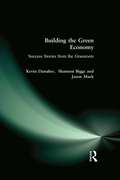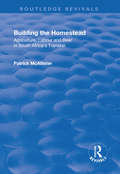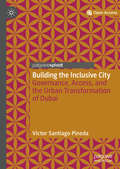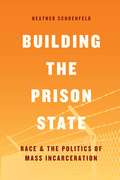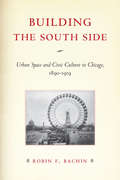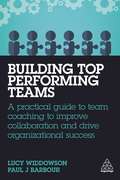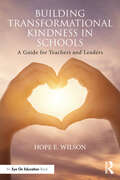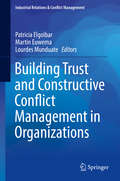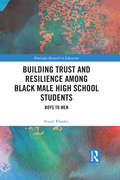- Table View
- List View
Building the Agile Business through Digital Transformation
by Neil Perkin Peter AbrahamBuilding the Agile Business through Digital Transformation is an in-depth look at transforming businesses so they are fit for purpose in a digitally enabled world. It is a guide for all those needing to better understand, implement and lead digital transformation in the workplace. It sets aside traditional thinking and outdated strategies to explain what steps need to be taken for an organization to become truly agile. It addresses how to build organizational velocity and establish iterative working, remove unnecessary process, embed innovation, map strategy to motivation and develop talent to succeed. Building the Agile Business through Digital Transformation provides guidance on how to set the pace and frequency for change and shows how to break old habits and reform the behaviours of a workforce to embed digital transformation, achieve organizational agility and ensure high performance. Full of practical advice, examples and real-life insights from organizational development professionals at the leading edge of digital transformation, this book is an essential guide to building an agile business.
Building the Agile Business through Digital Transformation
by Neil Perkin Peter AbrahamHow can businesses transform to achieve competitive advantage in a digital-enabled world? How can managers and leaders create a culture that supports lasting change through these transformations?Building the Agile Business through Digital Transformation is an in-depth guide for all those needing to better understand, implement and lead digital transformation in the workplace. It sets aside traditional thinking and outdated strategies to explain what steps need to be taken for an organization to become truly agile, embed innovation and develop talent to succeed.This majorly revised second edition of Building the Agile Business through Digital Transformation contains new material on the culture and mindset challenges of shifting at scale from linear to agile working, and using data effectively in organizational decision-making. Full of practical advice, examples and real-life insights from organizations at the leading edge of digital transformation including AirBnb, Amazon and Google, this book is an essential guide to driving success by becoming an agile and digital native business.
Building the City of Spectacle: Mayor Richard M. Daley and the Remaking of Chicago
by Costas Spirou Dennis R. JuddBy the time he left office on May 16, 2011, Mayor Richard M. Daley had served six terms and more than twenty-two years at the helm of Chicago’s City Hall, making him the longest serving mayor in the city’s history. Richard M. Daley was the son of the legendary machine boss, Mayor Richard J. Daley, who had presided over the city during the post–World War II urban crisis. Richard M. Daley led a period of economic restructuring after that difficult era by building a vibrant tourist economy. Costas Spirou and Dennis R. Judd focus on Richard M. Daley’s role in transforming Chicago’s economy and urban culture.The construction of the "city of spectacle" required that Daley deploy leadership and vision to remake Chicago’s image and physical infrastructure. He gained the resources and political power necessary for supporting an aggressive program of construction that focused on signature projects along the city’s lakefront, including especially Millennium Park, Navy Pier, the Museum Campus, Northerly Island, Soldier Field, and two major expansions of McCormick Place, the city’s convention center. During this period Daley also presided over major residential construction in the Loop and in the surrounding neighborhoods, devoted millions of dollars to beautification efforts across the city, and increased the number of summer festivals and events across Grant Park. As a result of all these initiatives, the number of tourists visiting Chicago skyrocketed during the Daley years.Daley has been harshly criticized in some quarters for building a tourist-oriented economy and infrastructure at the expense of other priorities. Daley left his successor, Rahm Emanuel, with serious issues involving a long-standing pattern of police malfeasance, underfunded and uneven schools, inadequate housing opportunities, and intractable budgetary crises. Nevertheless, Spirou and Judd conclude, because Daley helped transform Chicago into a leading global city with an exceptional urban culture, he also left a positive imprint on the city that will endure for decades to come.
Building the e-World Ecosystem: 11th IFIP WG 6.11 Conference on e-Business, e-Services, and e-Society, I3E 2011, Kaunas, Lithuania, October 12-14, 2011, Revised Selected Papers (IFIP Advances in Information and Communication Technology #353)
by Tomas Skersys Rimantas Butleris Lina Nemuraite Reima SuomiThis book constitutes the thoroughly refereed post-conference proceedings of the 11th IFIP WG 6.11 Conference on e-Business, e-Services and e-Society, I3E 2011, held in Kaunas, Lithuania, in October 2011. The 25 revised papers presented were carefully reviewed and selected from numerous submissions. They are organized in the following topical sections: e-government and e-governance, e-services, digital goods and products, e-business process modeling and re-engineering, innovative e-business models and implementation, e-health and e-education, and innovative e-business models.
Building the Ghanaian Nation-State: Kwame Nkrumah’s Symbolic Nationalism (African Histories and Modernities)
by H. FullerGhana has always held a position of primacy in the African political and historical imagination, due in no small part to the indelible impression left president Kwame Nkrumah. This study examines the symbolic strategies he used to construct the Ghanaian state through currency, stamps, museums, flags, and other public icons.
Building the Green Economy: Success Stories from the Grassroots
by Kevin Danaher Shannon Biggs Jason MarkAfter centuries of economic activity based on extraction, exploitation, and depletion, we now face undeniable environmental threats. New business models that save or restore natural resources are critical. But how can we translate that insight into more sustainable practices?Building the Green Economy shows how community groups, families, and individual citizens have taken action to protect their food and water, clean up their neighborhoods, and strengthen their local economies. Their unlikely victories—over polluters, unresponsive bureaucracies, and unexamined routines—dramatize the opportunities and challenges facing the local green economy movement.Drawing on their extensive experience at Global Exchange and elsewhere, the authors also:Lay out strategies for a more successful green movementDescribe how communities have protected their victories from legal and political challengesProvide key resources for local activistsInclude conversations with Rocky Anderson, Lois Gibbs, Anuradha Mittal, David Morris, Michael Shuman, and other activists and leaders.
Building the Green Economy: Success Stories from the Grassroots
by Kevin Danaher Shannon Biggs Jason MarkAfter centuries of economic activity based on extraction, exploitation, and depletion, we now face undeniable environmental threats. New business models that save or restore natural resources are critical. But how can we translate that insight into more sustainable practices?Building the Green Economy shows how community groups, families, and individual citizens have taken action to protect their food and water, clean up their neighborhoods, and strengthen their local economies. Their unlikely victories—over polluters, unresponsive bureaucracies, and unexamined routines—dramatize the opportunities and challenges facing the local green economy movement.Drawing on their extensive experience at Global Exchange and elsewhere, the authors also:Lay out strategies for a more successful green movementDescribe how communities have protected their victories from legal and political challengesProvide key resources for local activistsInclude conversations with Rocky Anderson, Lois Gibbs, Anuradha Mittal, David Morris, Michael Shuman, and other activists and leaders.
Building the Homestead: Agriculture, Labour and Beer in South Africa's Transkei
by P. McAllisterThis title was first published in 2001. "This is also a study of rural Xhosa identity and community, and its survival in the face of the overwhelming odds stacked against it by colonialism and apartheid. The maintenance of homestead production can be properly understood only if this wider context is taken into consideration. The analysis is thus directly relevant to current debates about agrarian change, land reform and economic development in South Africa's communal areas, since it shows how some rural Xhosa are able to maintain a sense of community and identity, and of how they are able to harness the socio-cultural resources at their disposal to engage in productive activity, with some success."--BOOK JACKET.
Building the Homestead: Agriculture, Labour and Beer in South Africa's Transkei
by P. McAllisterThis title was first published in 2001. "This is also a study of rural Xhosa identity and community, and its survival in the face of the overwhelming odds stacked against it by colonialism and apartheid. The maintenance of homestead production can be properly understood only if this wider context is taken into consideration. The analysis is thus directly relevant to current debates about agrarian change, land reform and economic development in South Africa's communal areas, since it shows how some rural Xhosa are able to maintain a sense of community and identity, and of how they are able to harness the socio-cultural resources at their disposal to engage in productive activity, with some success."--BOOK JACKET.
Building the Inclusive City: Governance, Access, and the Urban Transformation of Dubai
by Victor Santiago PinedaThis Open Access book is an anthropological urban study of the Emirate of Dubai, its institutions, and their evolution. It provides a contemporary history of disability in city planning from a non-Western perspective and explores the cultural context for its positioning. Three insights inform the author’s approach. First, disability research, much like other urban or social issues, must be situated in a particular place. Second, access and inclusion forms a key part of both local and global planning issues. Third, a 21st century planning education should take access and inclusion into consideration by applying a disability lens to the empirical, methodological, and theoretical advances of the field. By bridging theory and practice, this book provides new insights on inclusive city planning and comparative urban theory. This book should be read as part of a larger struggle to define and assert access; it’s a story of how equity and justice are central themes in building the cities of the future and of today.
Building the Prison State: Race and the Politics of Mass Incarceration (Chicago Series in Law and Society)
by Heather SchoenfeldThe United States incarcerates more people per capita than any other industrialized nation in the world—about 1 in 100 adults, or more than 2 million people—while national spending on prisons has catapulted 400 percent. Given the vast racial disparities in incarceration, the prison system also reinforces race and class divisions. How and why did we become the world’s leading jailer? And what can we, as a society, do about it? Reframing the story of mass incarceration, Heather Schoenfeld illustrates how the unfinished task of full equality for African Americans led to a series of policy choices that expanded the government’s power to punish, even as they were designed to protect individuals from arbitrary state violence. Examining civil rights protests, prison condition lawsuits, sentencing reforms, the War on Drugs, and the rise of conservative Tea Party politics, Schoenfeld explains why politicians veered from skepticism of prisons to an embrace of incarceration as the appropriate response to crime. To reduce the number of people behind bars, Schoenfeld argues that we must transform the political incentives for imprisonment and develop a new ideological basis for punishment.
Building the Prison State: Race and the Politics of Mass Incarceration (Chicago Series in Law and Society)
by Heather SchoenfeldThe United States incarcerates more people per capita than any other industrialized nation in the world—about 1 in 100 adults, or more than 2 million people—while national spending on prisons has catapulted 400 percent. Given the vast racial disparities in incarceration, the prison system also reinforces race and class divisions. How and why did we become the world’s leading jailer? And what can we, as a society, do about it? Reframing the story of mass incarceration, Heather Schoenfeld illustrates how the unfinished task of full equality for African Americans led to a series of policy choices that expanded the government’s power to punish, even as they were designed to protect individuals from arbitrary state violence. Examining civil rights protests, prison condition lawsuits, sentencing reforms, the War on Drugs, and the rise of conservative Tea Party politics, Schoenfeld explains why politicians veered from skepticism of prisons to an embrace of incarceration as the appropriate response to crime. To reduce the number of people behind bars, Schoenfeld argues that we must transform the political incentives for imprisonment and develop a new ideological basis for punishment.
Building the Prison State: Race and the Politics of Mass Incarceration (Chicago Series in Law and Society)
by Heather SchoenfeldThe United States incarcerates more people per capita than any other industrialized nation in the world—about 1 in 100 adults, or more than 2 million people—while national spending on prisons has catapulted 400 percent. Given the vast racial disparities in incarceration, the prison system also reinforces race and class divisions. How and why did we become the world’s leading jailer? And what can we, as a society, do about it? Reframing the story of mass incarceration, Heather Schoenfeld illustrates how the unfinished task of full equality for African Americans led to a series of policy choices that expanded the government’s power to punish, even as they were designed to protect individuals from arbitrary state violence. Examining civil rights protests, prison condition lawsuits, sentencing reforms, the War on Drugs, and the rise of conservative Tea Party politics, Schoenfeld explains why politicians veered from skepticism of prisons to an embrace of incarceration as the appropriate response to crime. To reduce the number of people behind bars, Schoenfeld argues that we must transform the political incentives for imprisonment and develop a new ideological basis for punishment.
Building the Prison State: Race and the Politics of Mass Incarceration (Chicago Series in Law and Society)
by Heather SchoenfeldThe United States incarcerates more people per capita than any other industrialized nation in the world—about 1 in 100 adults, or more than 2 million people—while national spending on prisons has catapulted 400 percent. Given the vast racial disparities in incarceration, the prison system also reinforces race and class divisions. How and why did we become the world’s leading jailer? And what can we, as a society, do about it? Reframing the story of mass incarceration, Heather Schoenfeld illustrates how the unfinished task of full equality for African Americans led to a series of policy choices that expanded the government’s power to punish, even as they were designed to protect individuals from arbitrary state violence. Examining civil rights protests, prison condition lawsuits, sentencing reforms, the War on Drugs, and the rise of conservative Tea Party politics, Schoenfeld explains why politicians veered from skepticism of prisons to an embrace of incarceration as the appropriate response to crime. To reduce the number of people behind bars, Schoenfeld argues that we must transform the political incentives for imprisonment and develop a new ideological basis for punishment.
Building the Prison State: Race and the Politics of Mass Incarceration (Chicago Series in Law and Society)
by Heather SchoenfeldThe United States incarcerates more people per capita than any other industrialized nation in the world—about 1 in 100 adults, or more than 2 million people—while national spending on prisons has catapulted 400 percent. Given the vast racial disparities in incarceration, the prison system also reinforces race and class divisions. How and why did we become the world’s leading jailer? And what can we, as a society, do about it? Reframing the story of mass incarceration, Heather Schoenfeld illustrates how the unfinished task of full equality for African Americans led to a series of policy choices that expanded the government’s power to punish, even as they were designed to protect individuals from arbitrary state violence. Examining civil rights protests, prison condition lawsuits, sentencing reforms, the War on Drugs, and the rise of conservative Tea Party politics, Schoenfeld explains why politicians veered from skepticism of prisons to an embrace of incarceration as the appropriate response to crime. To reduce the number of people behind bars, Schoenfeld argues that we must transform the political incentives for imprisonment and develop a new ideological basis for punishment.
Building the Prison State: Race and the Politics of Mass Incarceration (Chicago Series in Law and Society)
by Heather SchoenfeldThe United States incarcerates more people per capita than any other industrialized nation in the world—about 1 in 100 adults, or more than 2 million people—while national spending on prisons has catapulted 400 percent. Given the vast racial disparities in incarceration, the prison system also reinforces race and class divisions. How and why did we become the world’s leading jailer? And what can we, as a society, do about it? Reframing the story of mass incarceration, Heather Schoenfeld illustrates how the unfinished task of full equality for African Americans led to a series of policy choices that expanded the government’s power to punish, even as they were designed to protect individuals from arbitrary state violence. Examining civil rights protests, prison condition lawsuits, sentencing reforms, the War on Drugs, and the rise of conservative Tea Party politics, Schoenfeld explains why politicians veered from skepticism of prisons to an embrace of incarceration as the appropriate response to crime. To reduce the number of people behind bars, Schoenfeld argues that we must transform the political incentives for imprisonment and develop a new ideological basis for punishment.
Building the South Side: Urban Space and Civic Culture in Chicago, 1890-1919 (Historical Studies of Urban America)
by Robin F. BachinBuilding the South Side explores the struggle for influence that dominated the planning and development of Chicago's South Side during the Progressive Era. Robin F. Bachin examines the early days of the University of Chicago, Chicago’s public parks, Comiskey Park, and the Black Belt to consider how community leaders looked to the physical design of the city to shape its culture and promote civic interaction. Bachin highlights how the creation of a local terrain of civic culture was a contested process, with the battle for cultural authority transforming urban politics and blurring the line between private and public space. In the process, universities, parks and playgrounds, and commercial entertainment districts emerged as alternative arenas of civic engagement. “Bachin incisively charts the development of key urban institutions and landscapes that helped constitute the messy vitality of Chicago’s late nineteenth- and early twentieth-century public realm.”—Daniel Bluestone, Journal of American History "This is an ambitious book filled with important insights about issues of public space and its use by urban residents. . . . It is thoughtful, very well written, and should be read and appreciated by anyone interested in Chicago or cities generally. It is also a gentle reminder that people are as important as structures and spaces in trying to understand urban development." —Maureen A. Flanagan, American Historical Review
Building the South Side: Urban Space and Civic Culture in Chicago, 1890-1919 (Historical Studies of Urban America)
by Robin F. BachinBuilding the South Side explores the struggle for influence that dominated the planning and development of Chicago's South Side during the Progressive Era. Robin F. Bachin examines the early days of the University of Chicago, Chicago’s public parks, Comiskey Park, and the Black Belt to consider how community leaders looked to the physical design of the city to shape its culture and promote civic interaction. Bachin highlights how the creation of a local terrain of civic culture was a contested process, with the battle for cultural authority transforming urban politics and blurring the line between private and public space. In the process, universities, parks and playgrounds, and commercial entertainment districts emerged as alternative arenas of civic engagement. “Bachin incisively charts the development of key urban institutions and landscapes that helped constitute the messy vitality of Chicago’s late nineteenth- and early twentieth-century public realm.”—Daniel Bluestone, Journal of American History "This is an ambitious book filled with important insights about issues of public space and its use by urban residents. . . . It is thoughtful, very well written, and should be read and appreciated by anyone interested in Chicago or cities generally. It is also a gentle reminder that people are as important as structures and spaces in trying to understand urban development." —Maureen A. Flanagan, American Historical Review
Building the South Side: Urban Space and Civic Culture in Chicago, 1890-1919 (Historical Studies of Urban America)
by Robin F. BachinBuilding the South Side explores the struggle for influence that dominated the planning and development of Chicago's South Side during the Progressive Era. Robin F. Bachin examines the early days of the University of Chicago, Chicago’s public parks, Comiskey Park, and the Black Belt to consider how community leaders looked to the physical design of the city to shape its culture and promote civic interaction. Bachin highlights how the creation of a local terrain of civic culture was a contested process, with the battle for cultural authority transforming urban politics and blurring the line between private and public space. In the process, universities, parks and playgrounds, and commercial entertainment districts emerged as alternative arenas of civic engagement. “Bachin incisively charts the development of key urban institutions and landscapes that helped constitute the messy vitality of Chicago’s late nineteenth- and early twentieth-century public realm.”—Daniel Bluestone, Journal of American History "This is an ambitious book filled with important insights about issues of public space and its use by urban residents. . . . It is thoughtful, very well written, and should be read and appreciated by anyone interested in Chicago or cities generally. It is also a gentle reminder that people are as important as structures and spaces in trying to understand urban development." —Maureen A. Flanagan, American Historical Review
Building Top-Performing Teams: A Practical Guide to Team Coaching to Improve Collaboration and Drive Organizational Success
by Lucy Widdowson Paul J BarbourThe best way for a business to succeed is through its people. While there are gains to be had from streamlining processes, reducing costs or making a strategic change, the biggest potential for success comes through how humans collaborate. Specifically, the greatest gains are achieved through high performing teams, and teams of teams. Containing more than 40 tools which can be used in a virtual or in-person coaching environment, Building Top-Performing Teams is a practical guide for leaders, HR professionals, coaches, team coaches and anyone with management responsibility. It covers how to motivate, develop, engage and reward a team of employees with different levels of experience and priorities to achieve outstanding business success.Building Top-Performing Teams includes essential guidance, tools and techniques that show how to promote team ways of working rather than individual-focused processes. It also includes guidance on managing internal team conflict and ensuring that teams are purpose-driven and working towards a shared business goal. Each chapter includes diagnostic questions and reflective practice exercises to allow readers to identify how to apply each element of team development to their workforce. Supported by the authors' experience in organizations such as the BBC, John Lewis, KPMG, Britvic, the NHS and BMW this is essential reading for anyone needing to unlock the value of teams to achieve greater business performance.
Building Transformational Kindness in Schools: A Guide for Teachers and Leaders
by Hope E. WilsonBeing kind in education is about much more than being nice. This unique book shows how transformational kindness needs to be an explicit, essential part of classroom and school culture in order to improve student success. Author Hope E. Wilson offers practical steps for creating a culture of transformational kindness through your approach to classroom management, relationships, assessment, and the content areas. She also demonstrates how to build kindness toward colleagues, parents, and families, and what to do in situations where supervisors are not so supportive. Finally, she describes how you can show more kindness toward yourself, including by giving grace. Throughout this book, you’ll find vignettes about the educators who have influenced their own communities through transformational kindness. You’ll come away feeling inspired and encouraged to imagine a world in which schools are places where kindness and humanity are felt by all.
Building Transformational Kindness in Schools: A Guide for Teachers and Leaders
by Hope E. WilsonBeing kind in education is about much more than being nice. This unique book shows how transformational kindness needs to be an explicit, essential part of classroom and school culture in order to improve student success. Author Hope E. Wilson offers practical steps for creating a culture of transformational kindness through your approach to classroom management, relationships, assessment, and the content areas. She also demonstrates how to build kindness toward colleagues, parents, and families, and what to do in situations where supervisors are not so supportive. Finally, she describes how you can show more kindness toward yourself, including by giving grace. Throughout this book, you’ll find vignettes about the educators who have influenced their own communities through transformational kindness. You’ll come away feeling inspired and encouraged to imagine a world in which schools are places where kindness and humanity are felt by all.
Building Trust and Constructive Conflict Management in Organizations (Industrial Relations & Conflict Management)
by Patricia Elgoibar Martin Euwema Lourdes MunduateThis book presents the most recent theoretical insights and practical intervention methods to (re)build trust between management and organized employees in organizations. Offering a multidisciplinary perspective on trust and conflict management in organizations, the book draws from diverse fields such as organizational psychology, business, law, industrial relations and sociology. It examines the often encountered breaches of trust between management and organized workers, and the resulting destructive social conflicts, social actions, strikes or dramatic business decisions. Its focus is on trust and conflict management at the organizational level in an industrial relations context: that of employee representatives and management. The book introduces a new theoretical approach: the Tree of Trust, designed to analyse and mediate the interconnected levels of trust and distrust in industrial relations. It presents case studies and practical recommendations to build trust and constructive conflict management in the organizations, and illustrates these by means of experiences from different countries around the globe.
Building Trust and Resilience among Black Male High School Students: Boys to Men (Routledge Research in Education #26)
by Stuart RhodenCentered on a case study of a mid-Atlantic charter school, this book identifies the key factors that help Black male students navigate high school in spite of traditional and historical barriers. Rather than examining their experiences through a deficit model, this book adds to the growing body of data on the importance of positive role models—including parents, peers, teachers, and administrators—in facilitating socio-emotional and academic success at the secondary and postsecondary level. Rhoden demonstrates that encouraging trust and persistence in Black male students are essential components to positive academic and social achievement in the face of perceived and real structural inequalities.
Building Trust and Resilience among Black Male High School Students: Boys to Men (Routledge Research in Education #26)
by Stuart RhodenCentered on a case study of a mid-Atlantic charter school, this book identifies the key factors that help Black male students navigate high school in spite of traditional and historical barriers. Rather than examining their experiences through a deficit model, this book adds to the growing body of data on the importance of positive role models—including parents, peers, teachers, and administrators—in facilitating socio-emotional and academic success at the secondary and postsecondary level. Rhoden demonstrates that encouraging trust and persistence in Black male students are essential components to positive academic and social achievement in the face of perceived and real structural inequalities.
